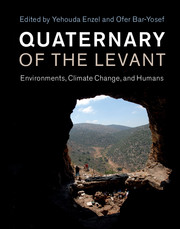Book contents
- Quaternary of the Levant
- Quaternary of the Levant
- Copyright page
- Contents
- Contributors
- Acknowledgements
- 1 The Quaternary of the Levant
- Part I: The Evolution of Current Landscapes and Basins
- Part II: Palaeoclimates
- Part III: Archaeology of Human Evolution
- Part IV: Palaeoecology
- Part V: Quaternary Geomorphology
- 46 Cosmogenic-Isotope Based Erosion Rates along the Western Margin of the Dead Sea Fault
- 47 Palaeogeography and Palaeohydrology of Fluvial Systems in the Levant, Southeastern Mediterranean
- 48 Quaternary Fluvial Environments and Palaeohydrology in Syria
- 49 Stable Carbon and Oxygen Isotope Signatures of Pedogenic Carbonates in Arid and Extremely Arid Environments in the Levant
- 50 Evolution of the Southeastern Mediterranean Coastal Plain
- 51 Middle–Late Quaternary Wetlands along the Coastal Plain of Israel
- 52 The Fluvial Systems
- 53 Loess in the Negev Desert: Sources, Loessial Soils, Palaeosols, and Palaeoclimatic Implications
- 54 Isotopic Tracers of Dust and Loess in the Levant
- 55 Loess, Dunes, and Human Activities
- 56 Late Quaternary Chronologies of the Northern Sinai/Northwestern Negev Dunefield and their Palaeoclimatic and Palaeoenvironmental Implications
- 57 Aridisols in the Southern Levant Deserts and their Palaeoclimate Implications
- 58 Quaternary Sediments and Soils of Jordan
- Part VI: Humans in the Levant
- Index
- Plate section
- References
51 - Middle–Late Quaternary Wetlands along the Coastal Plain of Israel
from Part V: - Quaternary Geomorphology
Published online by Cambridge University Press: 04 May 2017
- Quaternary of the Levant
- Quaternary of the Levant
- Copyright page
- Contents
- Contributors
- Acknowledgements
- 1 The Quaternary of the Levant
- Part I: The Evolution of Current Landscapes and Basins
- Part II: Palaeoclimates
- Part III: Archaeology of Human Evolution
- Part IV: Palaeoecology
- Part V: Quaternary Geomorphology
- 46 Cosmogenic-Isotope Based Erosion Rates along the Western Margin of the Dead Sea Fault
- 47 Palaeogeography and Palaeohydrology of Fluvial Systems in the Levant, Southeastern Mediterranean
- 48 Quaternary Fluvial Environments and Palaeohydrology in Syria
- 49 Stable Carbon and Oxygen Isotope Signatures of Pedogenic Carbonates in Arid and Extremely Arid Environments in the Levant
- 50 Evolution of the Southeastern Mediterranean Coastal Plain
- 51 Middle–Late Quaternary Wetlands along the Coastal Plain of Israel
- 52 The Fluvial Systems
- 53 Loess in the Negev Desert: Sources, Loessial Soils, Palaeosols, and Palaeoclimatic Implications
- 54 Isotopic Tracers of Dust and Loess in the Levant
- 55 Loess, Dunes, and Human Activities
- 56 Late Quaternary Chronologies of the Northern Sinai/Northwestern Negev Dunefield and their Palaeoclimatic and Palaeoenvironmental Implications
- 57 Aridisols in the Southern Levant Deserts and their Palaeoclimate Implications
- 58 Quaternary Sediments and Soils of Jordan
- Part VI: Humans in the Levant
- Index
- Plate section
- References
Summary
- Type
- Chapter
- Information
- Quaternary of the LevantEnvironments, Climate Change, and Humans, pp. 447 - 456Publisher: Cambridge University PressPrint publication year: 2017
References
- 2
- Cited by

